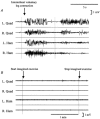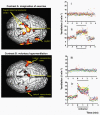Identification of higher brain centres that may encode the cardiorespiratory response to exercise in humans
- PMID: 11410638
- PMCID: PMC2278657
- DOI: 10.1111/j.1469-7793.2001.00823.x
Identification of higher brain centres that may encode the cardiorespiratory response to exercise in humans
Abstract
1. Positron emission tomography (PET) was used to identify the neuroanatomical correlates underlying 'central command' during imagination of exercise under hypnosis, in order to uncouple central command from peripheral feedback. 2. Three cognitive conditions were used: condition I, imagination of freewheeling downhill on a bicycle (no change in heart rate, HR, or ventilation, V(I)): condition II, imagination of exercise, cycling uphill (increased HR by 12 % and V(I) by 30 % of the actual exercise response): condition III, volitionally driven hyperventilation to match that achieved in condition II (no change in HR). 3. Subtraction methodology created contrast A (II minus I) highlighting cerebral areas involved in the imagination of exercise and contrast B (III minus I) highlighting areas activated in the direct volitional control of breathing (n = 4 for both; 8 scans per subject). End-tidal P(CO(2)) (P(ET,CO(2))) was held constant throughout PET scanning. 4. In contrast A, significant activations were seen in the right dorso-lateral prefrontal cortex, supplementary motor areas (SMA), the right premotor area (PMA), superolateral sensorimotor areas, thalamus, and bilaterally in the cerebellum. In contrast B, significant activations were present in the SMA and in lateral sensorimotor cortical areas. The SMA/PMA, dorso-lateral prefrontal cortex and the cerebellum are concerned with volitional/motor control, including that of the respiratory muscles. 5. The neuroanatomical areas activated suggest that a significant component of the respiratory response to 'exercise', in the absence of both movement feedback and an increase in CO(2) production, can be generated by what appears to be a behavioural response.
Figures


 ; B, ΔPET,CO2; C, Δf; D, ΔVT; E, ΔHR (bpm, beats per minute).
; B, ΔPET,CO2; C, Δf; D, ΔVT; E, ΔHR (bpm, beats per minute).
 ; B, ΔPET,CO2 (•, control; ○, isocapnic).
; B, ΔPET,CO2 (•, control; ○, isocapnic).



References
-
- Arvidsson T, Astrom H, Bevegard S, Jonsson B. Circulatory effects of suggested leg exercise and fear induced under hypnotic state. Progress in Respiration Research. 1970;5:365–374.
-
- Blessing WW. Inadequate frameworks for understanding bodily homeostasis. Trends in Neurosciences. 1997;20:235–239. - PubMed
-
- Coe W, St Jean R, Burger J. Hypnosis and the enhancement of visual imagery. International Journal of Clinical Experimental Hypnosis. 1980;28:225–243. - PubMed
Publication types
MeSH terms
LinkOut - more resources
Full Text Sources
Medical

